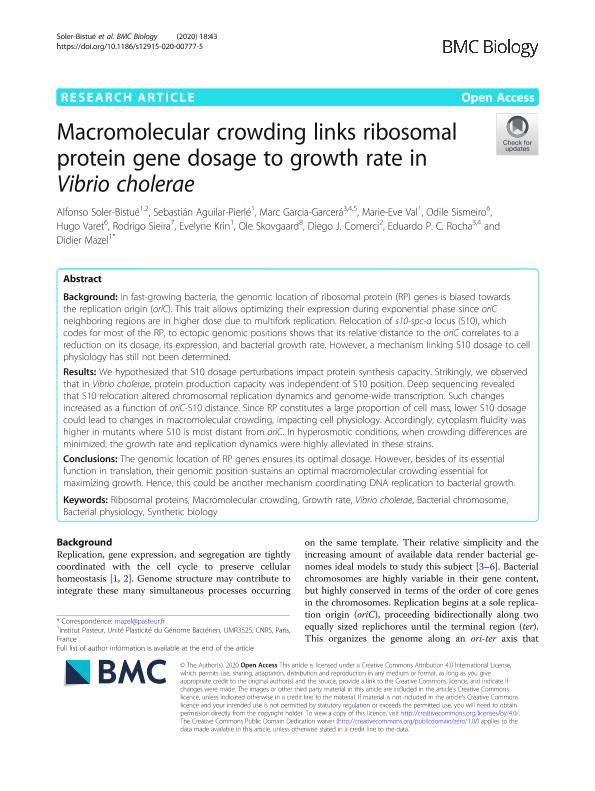Mostrar el registro sencillo del ítem
dc.contributor.author
Soler Bistue, Alfonso J. C.

dc.contributor.author
Aguilar Pierlé, Sebastián
dc.contributor.author
Garcia Garcerá, Marc
dc.contributor.author
Val, Marie Eve
dc.contributor.author
Sismeiro, Odile
dc.contributor.author
Varet, Hugo
dc.contributor.author
Sieira, Rodrigo

dc.contributor.author
Krin, Evelyne
dc.contributor.author
Skovgaard, Ole
dc.contributor.author
Comerci, Diego José

dc.contributor.author
Rocha, Eduardo P. C.
dc.contributor.author
Mazel, Didier
dc.date.available
2020-08-21T18:02:53Z
dc.date.issued
2020-04
dc.identifier.citation
Soler Bistue, Alfonso J. C.; Aguilar Pierlé, Sebastián; Garcia Garcerá, Marc; Val, Marie Eve; Sismeiro, Odile; et al.; Macromolecular crowding links ribosomal protein gene dosage to growth rate in Vibrio cholerae; BioMed Central; Bmc Biology; 18; 1; 4-2020; 1-18
dc.identifier.issn
1741-7007
dc.identifier.uri
http://hdl.handle.net/11336/112160
dc.description.abstract
In fast-growing bacteria, the genomic location of ribosomal protein (RP) genes is biased towards the replication origin (oriC). This trait allows optimizing their expression during exponential phase since oriC neighboring regions are in higher dose due to multifork replication. Relocation of s10-spc-α locus (S10), which codes for most of the RP, to ectopic genomic positions shows that its relative distance to the oriC correlates to a reduction on its dosage, its expression, and bacterial growth rate. However, a mechanism linking S10 dosage to cell physiology has still not been determined.We hypothesized that S10 dosage perturbations impact protein synthesis capacity. Strikingly, we observed that in Vibrio cholerae, protein production capacity was independent of S10 position. Deep sequencing revealed that S10 relocation altered chromosomal replication dynamics and genome-wide transcription. Such changes increased as a function of oriC-S10 distance. Since RP constitutes a large proportion of cell mass, lower S10 dosage could lead to changes in macromolecular crowding, impacting cell physiology. Accordingly, cytoplasm fluidity was higher in mutants where S10 is most distant from oriC. In hyperosmotic conditions, when crowding differences are minimized, the growth rate and replication dynamics were highly alleviated in these strains.The genomic location of RP genes ensures its optimal dosage. However, besides of its essential function in translation, their genomic position sustains an optimal macromolecular crowding essential for maximizing growth. Hence, this could be another mechanism coordinating DNA replication to bacterial growth.
dc.format
application/pdf
dc.language.iso
eng
dc.publisher
BioMed Central

dc.rights
info:eu-repo/semantics/openAccess
dc.rights.uri
https://creativecommons.org/licenses/by/2.5/ar/
dc.subject
VIBRIO CHOLERAE
dc.subject
RIBOSOMAL PROTEINS
dc.subject
GROWTH RATE
dc.subject
GENOMICS
dc.subject.classification
Bioquímica y Biología Molecular

dc.subject.classification
Ciencias Biológicas

dc.subject.classification
CIENCIAS NATURALES Y EXACTAS

dc.title
Macromolecular crowding links ribosomal protein gene dosage to growth rate in Vibrio cholerae
dc.type
info:eu-repo/semantics/article
dc.type
info:ar-repo/semantics/artículo
dc.type
info:eu-repo/semantics/publishedVersion
dc.date.updated
2020-06-08T15:08:01Z
dc.journal.volume
18
dc.journal.number
1
dc.journal.pagination
1-18
dc.journal.pais
Reino Unido

dc.journal.ciudad
Londres
dc.description.fil
Fil: Soler Bistue, Alfonso J. C.. Consejo Nacional de Investigaciones Científicas y Técnicas. Centro Científico Tecnológico Conicet - La Plata. Instituto de Investigaciones Biotecnológicas. Universidad Nacional de San Martín. Instituto de Investigaciones Biotecnológicas; Argentina
dc.description.fil
Fil: Aguilar Pierlé, Sebastián. Institut Pasteur; Francia
dc.description.fil
Fil: Garcia Garcerá, Marc. Institut Pasteur; Francia
dc.description.fil
Fil: Val, Marie Eve. Institut Pasteur; Francia
dc.description.fil
Fil: Sismeiro, Odile. Institut Pasteur; Francia
dc.description.fil
Fil: Varet, Hugo. Institut Pasteur; Francia
dc.description.fil
Fil: Sieira, Rodrigo. Consejo Nacional de Investigaciones Científicas y Técnicas. Oficina de Coordinación Administrativa Parque Centenario. Instituto de Investigaciones Bioquímicas de Buenos Aires. Fundación Instituto Leloir. Instituto de Investigaciones Bioquímicas de Buenos Aires; Argentina
dc.description.fil
Fil: Krin, Evelyne. Institut Pasteur; Francia
dc.description.fil
Fil: Skovgaard, Ole. Roskilde Universitet; Dinamarca
dc.description.fil
Fil: Comerci, Diego José. Universidad Nacional de San Martin. Instituto de Investigaciones Biotecnologicas. - Consejo Nacional de Investigaciones Cientificas y Tecnicas. Oficina de Coordinacion Administrativa Pque. Centenario. Instituto de Investigaciones Biotecnologicas.; Argentina
dc.description.fil
Fil: Rocha, Eduardo P. C.. Institut Pasteur; Francia
dc.description.fil
Fil: Mazel, Didier. Institut Pasteur; Francia
dc.journal.title
Bmc Biology

dc.relation.alternativeid
info:eu-repo/semantics/altIdentifier/url/https://bmcbiol.biomedcentral.com/articles/10.1186/s12915-020-00777-5
dc.relation.alternativeid
info:eu-repo/semantics/altIdentifier/doi/http://dx.doi.org/10.1186/s12915-020-00777-5
Archivos asociados
